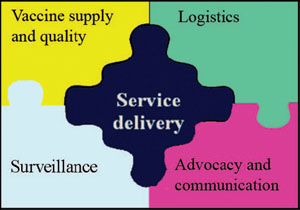
Advocacy and communication form one of the five key EPI operations (Figure 9.1), which you saw first in Study Session 1. Advocacy refers to ways of delivering an argument effectively, so that you gain the support and commitment of policy-makers, community members and other stakeholders, and are able to ‘put the case’ successfully for increasing immunization coverage. Communication is the transmission of information from one person to another, or from a source to a destination.

Immunization programmes may be unsuccessful if incorrect or inadequate information is transmitted to the community. Sometimes, even though correct information may be communicated, it may be ineffective in achieving the desired outcome. It is important that you, as a Health Extension Practitioner, use terms that are readily understood when you talk to members of the community, ensuring that you appreciate local problems and show respect for local customs and culture. One way to improve communication with members of your community would be to organise a committee to look into reasons why people do not come to be vaccinated, or do not complete their vaccinations. This would help you to:
What do you hope this would achieve in the long term?